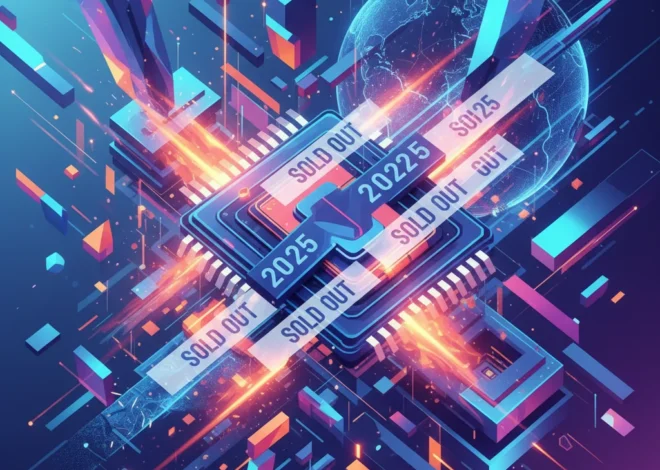
The AI Gold Rush’s Unsung Hero: How Foxconn is Building the Future (and It’s Not Just iPhones)
When you hear the name Foxconn, what comes to mind? For most of us, it’s the iconic image of sprawling factories, meticulously assembling the sleek iPhones and gadgets that define our digital lives. For decades, Foxconn has been the silent giant behind the consumer tech boom, the world’s largest contract electronics manufacturer. But a seismic shift is underway, one that’s happening deep inside the humming, climate-controlled data centers that power our world. And Foxconn is, once again, at the very heart of it.
The company, formally known as Hon Hai Precision Industry, recently made headlines for something other than a new smartphone launch. They announced a staggering 17% jump in quarterly profit, a surge driven not by phones, but by the insatiable demand for a different kind of hardware: AI servers. This isn’t just a minor uptick; it’s a powerful signal that the artificial intelligence revolution, often discussed in terms of software, algorithms, and cloud services, has a massive, tangible, and incredibly lucrative physical backbone. Foxconn, it turns out, is building it.
This news reveals a crucial truth for anyone in the tech industry—from developers and startup founders to investors and IT professionals. To understand the future of AI, you have to look beyond the code and understand the hardware that makes it all possible. Let’s dig into what’s happening, why it matters, and what it signals for the future of technology.
The “Picks and Shovels” of the Digital Gold Rush
History has a funny way of repeating itself. During the 19th-century gold rushes, the people who consistently made the most money weren’t the prospectors panning for gold, but the entrepreneurs selling the picks, shovels, and blue jeans. Today, we’re in a new kind of gold rush—the AI gold rush. The “gold” is groundbreaking machine learning models and innovative SaaS applications. And the “picks and shovels”? They are the specialized servers packed with powerful GPUs, the very machines that Foxconn is assembling in record numbers.
Foxconn has quietly become Nvidia’s biggest server maker, a pivotal role in the AI ecosystem. Nvidia designs the highly coveted GPUs (Graphics Processing Units) that are the engines of modern AI, but they don’t build the final server systems. That’s where Foxconn comes in. They take these powerful chips and integrate them into complex, high-performance server racks, which are then sold to the biggest names in tech—the cloud giants like Amazon Web Services, Microsoft Azure, and Google Cloud, who in turn rent that computing power out to the rest of us.
So, what exactly makes an AI server different from the servers that have been running our websites and databases for years? The difference is staggering, both in complexity and in cost.
Anatomy of an AI Server
Here’s a simplified breakdown of the key components that differentiate an AI server, the kind Foxconn is building, from a traditional one:
| Component | Traditional Server | AI Server (e.g., Nvidia DGX) |
|---|---|---|
| Primary Processor | CPU (Central Processing Unit) – Good for sequential, general-purpose tasks. | Multiple GPUs (Graphics Processing Units) – Optimized for parallel processing, ideal for machine learning calculations. Often 8 or more high-end GPUs like the H100. |
| Interconnect | Standard networking (Ethernet). | High-speed, low-latency interconnects (e.g., Nvidia NVLink/NVSwitch) to allow GPUs to communicate with each other as a single, massive processor. |
| Memory | DDR4/DDR5 RAM for the CPU. | High-Bandwidth Memory (HBM) integrated directly onto the GPU package, plus system RAM. This is crucial for feeding the data-hungry GPUs. |
| Power & Cooling | A few hundred watts per server. Air-cooled. | 10,000 watts (10kW) or more per server. Requires advanced air or even liquid cooling solutions to dissipate immense heat. |
| Cost | A few thousand dollars. | Hundreds of thousands of dollars per server. |
As the table shows, building an AI server is a feat of engineering. It’s a high-margin, high-complexity business that plays directly to Foxconn’s strengths in manufacturing and supply chain management, representing a significant evolution from its consumer electronics roots.
Australia's Teen Social Media Ban: A Tech Minefield or a Cybersecurity Gold Rush?
A Strategic Pivot from Phones to a New Frontier
For years, analysts have pointed to Foxconn’s heavy reliance on Apple as its biggest vulnerability. The consumer electronics market is famously cyclical and operates on razor-thin margins. The move into AI servers is a brilliant strategic pivot, diversifying its revenue and moving it up the value chain into a more profitable, enterprise-focused market.
This isn’t just about chasing a hot trend. It’s about securing a future beyond the smartphone. The demand for AI infrastructure is structural, not cyclical. Every major technological leap forward—from cloud computing and SaaS to automation and advanced cybersecurity—now relies on a foundation of powerful machine learning models. These models require constant training and inference on massive fleets of servers, creating a durable, long-term demand cycle.
Foxconn’s leadership is keenly aware of this. Chairman Young Liu has expressed a significantly more optimistic outlook for the company’s performance, directly attributing it to the boom in AI server demand (source). This shift is part of a broader strategy that also includes ventures into electric vehicles and semiconductors, all aimed at transforming Foxconn from a contract manufacturer into a comprehensive technology solutions provider.
What This Hardware Boom Means for the Rest of Us
The ripple effects of this hardware-centric boom extend far beyond Foxconn’s balance sheet. They directly impact everyone working in technology.
- For Developers and Programmers: The hardware being assembled in Foxconn’s factories is the very infrastructure you’re deploying code to. The architecture of these servers—with their emphasis on parallel processing and high-speed interconnects—is influencing software development. Proficiency in programming frameworks like CUDA, which unlock the power of Nvidia’s GPUs, is becoming an increasingly valuable skill.
- For Startups and Entrepreneurs: While the cost of building your own AI data center is prohibitive, the availability of this hardware through cloud providers is what enables the current wave of AI startups. However, the high cost of this hardware translates directly into high cloud bills for training and running models. This economic reality is forcing startups to innovate in model optimization, efficiency, and finding niche applications that don’t require planet-sized models to be viable.
- For Cybersecurity Professionals: The centralization of immense computational power into massive data centers creates high-value targets for cyberattacks. Securing these AI servers, the valuable models they run, and the vast datasets they process is a critical and growing challenge. The innovation in hardware necessitates a parallel innovation in cybersecurity to protect against new threat vectors.
The Road Ahead: A Glimpse into the Future of Computing
The AI server boom is not without its challenges. The supply chain for high-end GPUs remains constrained, creating bottlenecks that can slow down progress. The immense energy consumption of these data centers raises serious environmental concerns that the industry is only beginning to grapple with. And as with any boom, there’s always the risk of an eventual bust or a slowdown in demand as the market matures.
However, the long-term trend is clear. We are moving toward a world of ubiquitous artificial intelligence, and that intelligence needs a physical home. Foxconn’s success is more than just a financial story; it’s a testament to the fundamental, industrial reality underpinning the digital revolution. The next great software innovation, the next leap in automation, the next breakthrough in machine learning—it’s all being built on a foundation of silicon, copper, and steel, meticulously assembled by the same hands that built the phone in your pocket.
The software may eat the world, but it runs on hardware. And right now, the business of building that hardware is better than ever.
Is the AI Gold Rush a House of Cards? Why a Top Bank is Quietly Hedging Its Bets

